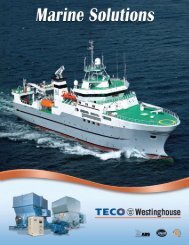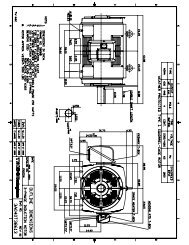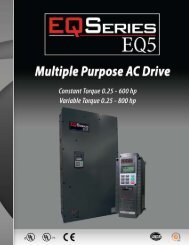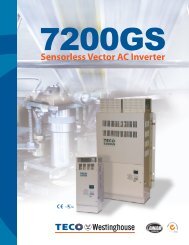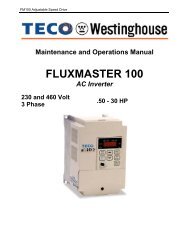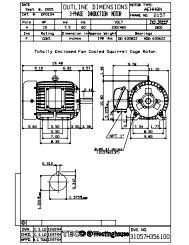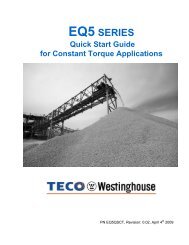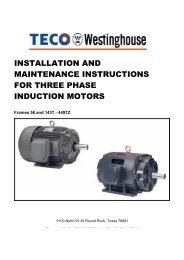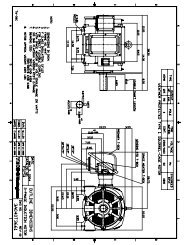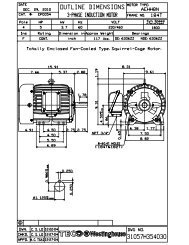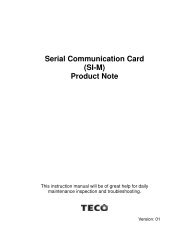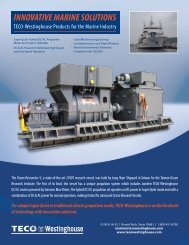EQ7 Series Instruction Manual - TECO-Westinghouse Motor Company
EQ7 Series Instruction Manual - TECO-Westinghouse Motor Company
EQ7 Series Instruction Manual - TECO-Westinghouse Motor Company
Create successful ePaper yourself
Turn your PDF publications into a flip-book with our unique Google optimized e-Paper software.
• Under vector control without speed sensor (F42 = 1 or 5)<br />
Data for F14<br />
Auto search disabled<br />
Description<br />
Auto search enabled<br />
0: Trip immediately As soon as the DC link bus voltage drops below the undervoltage detection level due to a<br />
momentary power failure, the inverter issues undervoltage alarm lu and shuts down its output so<br />
that the motor enters a coast-to-stop state.<br />
1: Trip after recovery<br />
from power failure<br />
2: Trip after<br />
decelerate-to-stop<br />
3: Continue to run<br />
(for heavy inertia or<br />
general loads)<br />
4: Restart at the<br />
frequency at which<br />
the power failure<br />
occurred<br />
(for general loads)<br />
5: Restart at the starting<br />
frequency<br />
As soon as the DC link bus voltage drops below the undervoltage detection level due to a<br />
momentary power failure, the inverter shuts down its output so that the motor enters a<br />
coast-to-stop state, but it does not enter the undervoltage state or issue undervoltage alarm lu .<br />
The moment the power is restored, an undervoltage alarm lu is issued, while the motor remains in<br />
a coast-to-stop state.<br />
As soon as the DC link bus voltage drops below the continuous running level due to a momentary<br />
power failure, decelerate-to-shop control is invoked. Decelerate-to-stop control regenerates kinetic<br />
energy from the load's moment of inertia, slowing down the motor and continuing the deceleration<br />
operation. After decelerate-to-stop operation, an undervoltage alarm lu is issued.<br />
As soon as the DC link bus voltage drops below the undervoltage detection level due to a<br />
momentary power failure, the inverter shuts down the output so that the motor enters a<br />
coast-to-stop state.<br />
If the F14 data is set to "3," the "Continue to run" function is disabled.<br />
If a run command has been input,<br />
restoring power restarts the inverter at the<br />
output frequency saved when<br />
undervoltage was detected.<br />
If a run command has been input, restoring power<br />
performs auto search for idling motor speed and<br />
restarts running the motor at the frequency calculated<br />
based on the searched speed.<br />
As soon as the DC link bus voltage drops below the undervoltage detection level due to a<br />
momentary power failure, the inverter shuts down the output so that the motor enters a<br />
coast-to-stop state.<br />
If a run command has been input,<br />
restoring power restarts the inverter at<br />
the starting frequency specified by<br />
function code F23.<br />
If a run command has been input, restoring power<br />
performs auto search for idling motor speed and<br />
restarts running the motor at the frequency calculated<br />
based on the searched speed.<br />
This setting is ideal for heavy load applications such as pumps, having a small moment of inertia,<br />
in which the motor speed quickly goes down to zero as soon as it enters a coast-to-stop state<br />
upon occurrence of a momentary power failure.<br />
Auto search is enabled by turning ON the digital terminal command STM ("Enable auto search for idling motor speed at<br />
starting") or setting the d67 data to "1" or "2."<br />
For details about the digital terminal command STM and auto search, refer to the description of d67 (Starting Mode, Auto<br />
search).<br />
• Under vector control with speed sensor (F42 = 6)<br />
Data for F14<br />
Description<br />
0: Trip immediately As soon as the DC link bus voltage drops below the undervoltage detection level due to a<br />
momentary power failure, the inverter issues undervoltage alarm lu and shuts down its output so<br />
that the motor enters a coast-to-stop state.<br />
1: Trip after recovery<br />
from power failure<br />
2: Trip after<br />
decelerate-to-stop<br />
3: Continue to run<br />
(for heavy inertia or<br />
general loads)<br />
4: Restart at the<br />
frequency at which<br />
the power failure<br />
occurred<br />
(for general loads)<br />
5: Restart at the starting<br />
frequency<br />
As soon as the DC link bus voltage drops below the undervoltage detection level due to a<br />
momentary power failure, the inverter shuts down its output so that the motor enters a<br />
coast-to-stop state, but it does not enter the undervoltage state or issue undervoltage alarm lu .<br />
The moment the power is restored, an undervoltage alarm lu is issued, while the motor remains in<br />
a coast-to-stop state.<br />
As soon as the DC link bus voltage drops below the continuous running level due to a momentary<br />
power failure, decelerate-to-shop control is invoked. Decelerate-to-stop control regenerates<br />
kinetic energy from the load's moment of inertia, slowing down the motor and continuing the<br />
deceleration operation. After decelerate-to-stop operation, an undervoltage alarm lu is issued.<br />
As soon as the DC link bus voltage drops below the undervoltage detection level due to a<br />
momentary power failure, the inverter shuts down the output so that the motor enters a<br />
coast-to-stop state.<br />
If the F14 data is set to "3," the "Continue to run" function is disabled.<br />
If a run command has been input, restoring power restarts the inverter at the motor speed<br />
detected by the speed sensor.<br />
4-44



